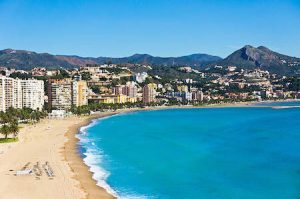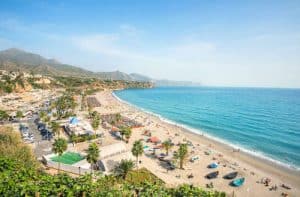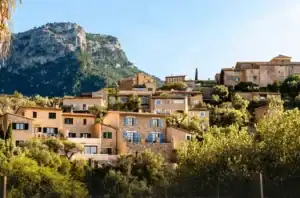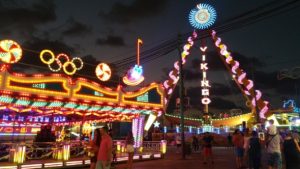Ronda is one of Spain’s oldest towns, settled by Celts in the sixth century BC and later inhabited by Romans and Moors. During the 19th century, it became a popular stop on the Grand Tour of Europe. After economic struggles and civil war in the early 20th century, Ronda has flourished in recent decades, developing into a prosperous destination that showcases both its rich history and natural beauty.

How to get to Ronda
Perched on the edge of the dramatic El Tajo gorge in southern Spain’s Andalucia region, Ronda is the crown jewel of the ‘pueblos blancos’ (white towns). The gorge splits the city in two parts – the historic Moorish quarter and the newer El Mercadillo district, connected by three picturesque bridges. Located in Málaga province, Ronda is conveniently accessible from Seville and Gibraltar.
By air – The closest airport to Ronda is in Malaga which has daily flights to and from destinations worldwide.
By car – If you’re driving from Malaga it will take you around 1 h 30 minutes, if you are in Seville count around 2 hours. Once you arrive in Ronda it’s best to park on the outskirts of the town rather than try to negotiate the narrow streets in the older part of town. There’s a 24-hour secure parking lot near the railway station (Parking Martinez Astein) or you may be able to find some ‘on street’ parking around this area (fifteen minute walk to the old town).
By train – Ronda sits on the Algeciras – Granada line and there are usually four direct trains a day on this route. The journey from Algeciras takes around 90 minutes with the first departure at 6.20 AM. The railway station is a 15 minutes walk to the city centre. The benefit of taking the train means that you can enjoy the scenery – particularly when the train passes through the Cañón de las Buitreras, or Vulture’s Canyon, just after Estacion de Gaucin.
There are also several trains per day between Malaga and Ronda, although these aren’t direct services. You can check current train times and prices on Rail Europe. However, Trains to Ronda are infrequent and usually involve a change at Antequera-Santa Ana. It takes around 2 hours from Málaga or 3 hours from Seville. By Bus – There are buses to Ronda from various towns and cities within Andalucia. You can check prices and timetables, as well as buy tickets, on Omio.com. The bus company operating in the region is Avanza Grupo (tickets can be purchased online).

Best time to visit Ronda
While there’s never really a bad time to visit Ronda, I’d recommend visiting in spring or autumn if at all possible. In summer, Ronda gets hot. Really hot. Average temperatures in July and August are around 30°c and, because it’s inland, there are no cooling sea breezes to make it bearable. During the winter months, the average temperatures hover around 10°c.
15 things to do in Ronda
Ronda is home to many different attractions, whether you prefer History, Culture, sightseeing or hiking, you will find something to please your curiosity in this town.
1. Puente Nuevo
The most recognisable landmark in Ronda and the emblem of the city on all the postcards! You should definitely cross the bridge for a picture stop at the Aldehuela viewpoint. To have the most beautiful view on the bridge, follow the Calle Tenorio until you reach the Plaza de Maria Auxiliadora.To learn more about the history of the bridge there’s a small museum inside the chamber above the central arch. Entry to the museum is 2.50 euros. The bridge crosses the Guadalevín River canyon, right in the center of the city. It’s a beautiful bridge in a jaw-dropping location. Despite its name, Ponte Nueva was completed in 1793.
2. Church of Nuestra Señora del Socorro
Situated near Plaza del Socorro, this Baroque church is known for its impressive facade and beautiful interiors. It’s worth climbing the bell tower for a beautiful panoramic view of the city. And you can also take a stroll in the beautiful square for a little break.

3. Casa Museo don Bosco
It sits on the edge of El Tajo gorge on the old town side of Ronda. At one point in its history, it was a nursing home for elderly and sick priests but is now a museum with a peaceful courtyard garden with views of the Puente Nuevo and across the Serranía de Ronda. During the spring and autumn months you can enjoy flamenco guitar concerts in the grand salon. Entry is about 2 euros.
4. The Desfiladero del Tajo
It’s the latest addition to Ronda’s tourist scene and is a walk down into the gorge towards the base of the Puente Nuevo on a walkway above the Guadalevin river. It was officially opened in April 2024 and is the first part of a plan to enable visitors to walk around the whole gorge. Tickets for this experience are 5 euros per person and, to avoid overcrowding, are limited to 30 people per hour. You can buy them in advance on the official website or get them on the day if there’s availability.
While the views from the Desfiladero del Tajo walk are spectacular, you can also hike further down into the gorge. From the entrance follow the path down where you’ll reach Mirador del Viento. You can continue on the path until you reach Mirador La Hoya del Tajo at the bottom of the gorge. And there’s a restaurant at the bottom, Albergue Los Molinos, which would be an ideal spot to eat with a view.
For serious hikers, this route makes up part of the GR7, the longest walking route in Europe, which starts in Tarifa and ends in Greece, and is also part of the Gran Senda de Malaga. If you’re visiting in late spring or summer be aware that it gets very hot in Ronda and there’s not much in the way of shade so make sure that you carry lots of water.
5. Palacio Mondragón
Just a short walk from Plaza de Maria Auxiliadora you’ll find Palacio Mondragón, a 14th century building renowned for its Moorish courtyards and gardens, as well as its views over the Sierra de Grazalema. The palace is also home to Ronda’s Municipal Museum where you can find out everything you need to know about Ronda’s history from the stone age onwards. Entry to Palacio Mondragón is 4.00 euros.
Ronda was also a walled city to further keep invaders at bay. What remains of the city walls, and the impressive Puerta de Almocabar, are on the opposite side of town to the main tourist sites so are often overlooked by day trippers.

6. Baños Arabes (Arab Baths)
From the entrance, you’ll find yourself overlooking the roof of the baths and, once inside, you’ll be able to see how the star shaped vents in the roof create patterns of light on the floor and walls. Entry to the baths and gardens is 4.50 euros. Ronda’s Arab Baths are some of the best preserved in Spain.
They were built during the town’s 12th-century Moorish period and were used by Muslims to purify themselves before visiting the mosque. The design is similar to a Roman bathhouse. You can explore the arched ceiling rooms with their star-shaped roof vents designed to let steam out and light in.
7. Puente Viejo and Puente de San Miguel
These are the other two bridges that connect the old and new parts of Ronda. The Puente San Miguel, also known as the Puente Arabe (Arab bridge), is Ronda’s smallest bridge. The Puente Viejo (old bridge) dates to the early 1600s and was the original bridge that connected the two parts of Ronda.
8. Museo Lara
This museum, just a few minutes’ walk from Puente Nuevo, is home to a collection of curios from around the world. Collected over his lifetime by Juan Antonio Lara Jurado there’s everything from clocks, weapons, and guitars, to typewriters, and scientific instruments. The highlight though is the witchcraft exhibition in the basement with a motley collection of exhibits. Entry to the museum is 4.00 euros.

9. Plaza de Toros
Worth visiting the bullring in Ronda for an insight into this controversial aspect of Spanish culture. Bullfighting even originates as an organised sport in Ronda. Though the origins of bullfighting are obscure, it was turned into a proper sport by Pedro Romero here in Ronda. Dating to the 18th century, Ronda holds Spain’s first bullfighting ring and they celebrate their heritage with a festival in September.
Entry includes access to the stables and stockyards, a small museum housing a collection of art plus bullfighting artefacts, as well as the bullring itself. It seats 5,000 spectators, one fight per year takes place there now. Entry to the bullring and museum is 9.00 euros. + If you’re a Madonna fan you might recognise it from her 1994 video, “Take a Bow”.
10. Parque Alameda del Tajo
This is a beautiful public park with yet more great views across the valley and is a lovely place to take a break from the sun. At one of the entrances to the park you’ll find statues of the writer Ernest Hemingway, several of his books are about his love of bullfighting. If you haven’t read any of Hemingway’s books, ‘Death in the Afternoon’ and ‘The Dangerous Summer’ are both about Ronda. And the American actor, Orson Well. Both had a special place in their hearts for Ronda.

11. Balcon del Coño
There are plenty of viewing points around Ronda but, to really test your nerve, step out onto the Balcon del Coño – the overhanging balcony near the bandstand in Parque Alameda del Tajo. Suspended over the gorge it gets its name from the ubiquitous Spanish swear word – presumably you step on the balcony, look down, say ‘coño’ and jump back.
12. Casa del Rey Moro
Despite its name ‘the home of a Moorish King’, it only dates back to the 18th century, though it was built on the site of an original Moorish well. Although the mansion isn’t open, you can visit the beautiful gardens designed by French landscape gardener Jean-Claude Forestier in 1912. The mine water system runs all the way down the gully to the Guadalevin River.
The biggest secret in Ronda is the water mill of the Casa. It is located inside the wall of the gorge and is accessible from the gardens through a tunnel of steps. When you walk downhill you will exit the tunnel and walk on a small platform right inside the El Tajo gorge and stand just a few feet above the river. Monday – Sunday from 10 AM – 9.30 PM. Entry is 10.00 euros.

13. Parcent Square
Continue onto Duchess of Parcent Square (Plaza Duquesa de Parcent); It’s surrounded by several monuments including the city hall but the most remarkable is undoubtedly the St Mary Major Church. The construction of this church took almost 200 years and presents a mixture of Renaissance and Gothic style.
14. The Bandit Museum
It’s located next to Plaza Duquesa, in Calle Arminan. This museum retraces the history of the region’s most famous outlaws through photos, documents and anecdotes about their lives. These men stole from the rich to help the poorest, with a spirit of justice. While being generous, they were merciless killers. A short unusual visit that will teach you a lot about this little-known aspect of the region.
15. Arab Walls
Ronda is a walled city. During the Muslim conquest of Spain, Ronda was used as a defence because it was located in a strategically important enclave. It has three sections, one to the south, one to the west and one to the east. Each of the sections has one or more gates: the Almocábar Gate, the Esparteros Gate, the Mills Gate, the Wind Gate and the Cijara Gate.

Best locations for Instagram pictures and TikTok reels in Ronda
Ronda is the home of many different landscapes, from woods to flower fields, fountains to luxury hotels, this city is worth a picture. All the attractions of Ronda deserve a flash, even though some are more memorable to take than others. Enjoy this photogenic town and its best shooting spots.
1. Puente Viejo
It’s a 16th-century stone bridge with amazing views over the gorge. As you know, Ronda is located on the top of a hill. If the famous Puente Nuevo bridge connects both parts of the city at the highest point of Ronda, then this one – Puente Viejo – is located on a much lower level. You can get the best photos of Puente Viejo bridge from another stone bridge located even more downhill – Puente de las Curtidurías or Puente Romano.
2. Casa Museo Don Bosco
It’s a unique 19th-century mansion with beautiful gardens and stunning views over the surroundings of Ronda and the famous El Tajo gorge. This aristocratic mansion was built around 1850 and today hosts different cultural events and is open for visitors of Ronda. The most beautiful part of this place is the garden with sculptures, balconies, and a beautiful fountain in a circular shape surrounded by benches made out of small tiles and ceramic decors. From the balcony, you can see the surroundings of Ronda and nearby mountains as far as the eye can see.
3. Iglesia de Santa María la Mayor church
Best spot to see Ronda from above. The thing about this church is that you can climb on the roof of it and see Ronda from above! Once you enter the church look for small doors near the altar – there is a narrow staircase that will lead you upwards to the roof. At the top of the staircase on the roof, you will notice another door. Don’t hesitate to bend over and enter them. You will be surprised by an unusual view!

4. Casa del Gigante
Its name comes from the two figures that were placed in the corners of the house. Only one of them is still standing. This small palace of the XIV and XV century, of Muslim style, has a unique character. The structure remains intact, a typical Nasrid palace that is organized around a central garden. It is one of the best preserved of the Nazari world and retains some corners reminiscent of the Alhambra.
5. Jardines de Cuenca
Dedicated to Cuenca, Ronda’s twin city since 1975, and offer yet another perspective of the Puente Nuevo. These terraced gardens on the new town side of Ronda cling to the side of the cliffs. A tour only for the bravest, where you can enjoy the wonderful views and the charm of its steep terraces. In this vertical garden, you can feel the adrenaline and take photographs that will be impressive even through the screen.
Opening Times are everyday from 8 AM to 10 PM. The gardens hide one of my favorite hidden gems and Instagram spots in Ronda – Mirador de Cuenca is a fantastic viewpoint overlooking the gorge and the famous Puente Nuevo bridge.

Ronda Awaits: A Journey Worth Taking in Southern Spain
Ronda is a captivating destination that beautifully blends history, culture, and natural beauty. With its iconic landmarks like Puente Nuevo, stunning views from the Desfiladero del Tajo walk, and the rich architectural heritage of the old town, it’s a photographer’s paradise. Whether you’re interested in exploring its centuries-old bridges, immersing yourself in Andalusian traditions, or simply capturing the picturesque landscapes, Ronda offers an unforgettable experience. For the best travel Instagram shots or TikTok reels, don’t miss the breathtaking views or its charming streets. With so much to see and do, Ronda is not just a day trip; it’s a place to truly immerse yourself in the spirit of southern Spain.












